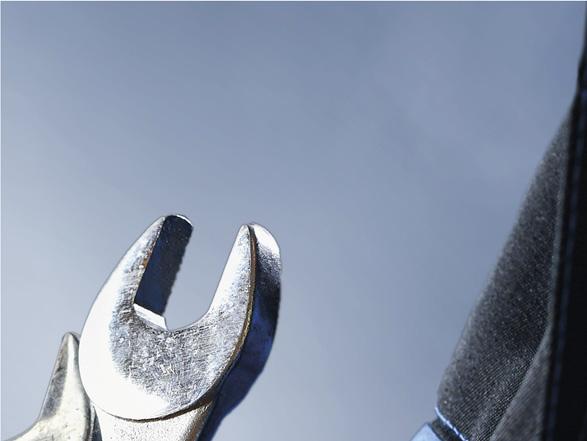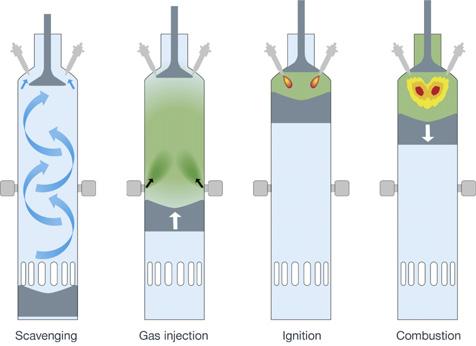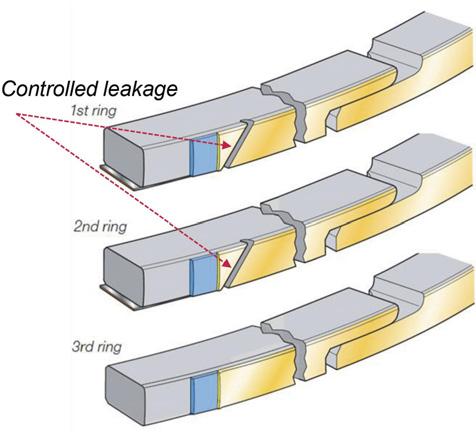
9 minute read
Fitting the right engine







Pádraig Kelleher, MAN Energy Solutions, Denmark, details the technology behind a new, low-speed, dual-fuel engine designed for LNG carriers.
MAN Energy Solutions demonstrated its latest low-speed, dual-fuel engine – a MAN B&W ME-GA type designed for LNG/fuel oil running – at a ceremony live-streamed from the company’s Copenhagen Research Centre, Denmark, in March 2021. The new engine is an Otto-cycle variant of the company’s successful ME-GI engine.
The ME-GA engine has already been specified in several LNG carrier new-building projects with the first order imminent, according to the company. Testing of the first, commercial ME-GA design is expected to begin by the end of 2021, with the first engine delivery following in early 2022.
The MAN B&W ME-GA engine is aimed at vessel types and applications where low capital outlay is a priority, such as Aframax tankers. Furthermore, the engine will be Tier III compliant in gas mode without emissions-abatement equipment.
The ME-GA engine features the following concepts: The well-proven MAN B&W dual-fuel platform. Unique gas admission concept with minimal installation and operating costs. Well-known engine room design similar to ME-C/ME-GI engines.
Engine philosophy
The ME-GA engine is a pre-mixed, dual-fuel engine type, where methane is admitted during the compression stroke (Figure 1). This allows for a low gas-supply pressure, which is advantageous for vessels with larger amounts of boil-off gas (BOG), such as LNG carriers.
The ME-GA version features some of the most successful concept ideas from ME-GI and ME-GI Mk. II platforms.
Gas admission concept
The simple supply and purging concept minimises installation costs. The gas admission system is designed to enable a safe and reliable operation at the lowest possible costs.
Supply and purging concept
The safety and purge concept from ME-GI Mk. II has been adapted to the ME-GA version with the introduction of beneficial features. Rather than injecting nitrogen from the gas valve unit (GVU), the nitrogen is applied at the engine end, and the purged volume carried along existing piping. This simplified solution reduces the amount of pipework and components, and significantly lowers the volume, reducing nitrogen consumption.
Safe gas admission valve
The safe gas admission valve (SGAV) placed in the cylinder liner has been developed as a unique and simple component, which provides both the ultimate safety against gas leakage into the cylinder and secures optimal conditions for gas admission.
Since the SGAV contains a gas admission as well as a window valve in one unit, the safety against gas leakage into the cylinder is doubled. Basically, the improved safety eliminates additional requirements for complex monitoring as a safety precaution, as opposed to other low-pressure, dual-fuel, two-stroke engines.
The SGAV design gives room for easy overhaul of the valve itself, along with maximum space for overhaul on the engine top.
Gas regulating valve
In order to achieve a simple and easy installation of the ME-GA engine and the








fuel supply system, a hydraulically-actuated, gas pressure regulating valve has been developed.
The valve is controlled directly from the engine control system, simplifying the requirements for control of the supply system.
Moreover, the gas regulating valve enables depressurising of the system without dedicated blow-off piping. The hydraulically-actuated bypass valve is of similar design to the ME-GI blow-off valve.

Figure 1. Pre-mixed dual-fuel combustion.

Figure 2. Design of the three piston ring package.
Figure 3. Milestones in the development of the ME-GA engine. MAN Energy Solutions aims to start testing the first commercial ME-GA design by the end of this year, with the first engine delivery following in early 2022.

Pressure-equalised, three piston ring package
MAN Energy Solutions’ experience with the development of piston ring configurations for different engine types, combined with know-how gained from ME-GI operations, has enabled the development of a rigid and reliable piston ring package for the ME-GA engine. A ring package similar to the wellknown, pressure-equalised, three-ring package for the ME-GI engine (Figure 2).
The properties of the three piston ring package are achieved by combining the controlled gas leakage of the first and second rings with a gas-tight third ring. The advantageous combination ensures an even pressure distribution, featuring: Minimum build-up of deposits in the ring grooves. More robustness against ring collapse than typical applications with a gas-tight top ring.
These properties are the basis for obtaining satisfactory cylinder conditions on the ME-GA engine and for giving the large freedom to optimise the combustion process.
The design of the ME-GI ring package has endured millions of running hours accumulated in service on MAN B&W G70 engines. Low wear rates show that the time between overhaul of piston crown and piston rings is well within MAN Energy Solutions’ guidance values.
Adaptive cylinder control
The ME-GA engine platform is being launched with MAN Energy Solutions’ new Triton engine management system. This system is being integrated with all new ME-GA engines, as well as ME-GI engines.
The solution includes an adaptive cylinder control function, which is an integral part of the Triton system. The unique adaptive cylinder control (ACCo) system used on MAN Energy Solutions’ ME-C and ME-GI engines also ensures the best performance and the lowest possible fuel consumption at all times for the ME-GA engine.
The system constantly monitors the maximum pressure, the compression pressure, and the mean efficient pressure on each cylinder, and automatically adjusts them if they deviate from shop test results. In this way, for example, counteracting the possible negative impact of varying fuel qualities and calorific values.
Pilot fuel
One particular area of focus has been the pilot fuel oil consumption, given its connection with NOx emissions in gas mode for Otto-cycle engines. In gas mode, the ME-GA engine required no more than 0.5% pilot fuel consumption. The ME-GA design also includes a microbooster system, which allowed high sulfur fuel oil to be used for pilot fuel injection in Tier II gas mode.
Cylinder oil requirements
The ME-GA engine is expected to have similar cylinder oil requirements to the existing ME-GI engine. While MAN Energy Solutions recommends the use of a BN40 Category II cylinder oil as soon as it becomes available, it would currently recommend a BN100 Category II cylinder oil.
Combining the ME-GA engine with EGR
Unlike other two-stroke manufacturers’ Otto-cycle low-speed engine after-treatment options, the ME-GA employs a high-pressure EGR system. While this requires a blower and small, associated parasitic load-increase, it means the system fits into existing engine rooms.
EGR is an option available for the ME-GA engine to ensure Tier III compliance when running on diesel. EGR is an effective way of reducing NOx emissions from the diesel combustion process with only a marginal negative impact on the combustion process itself (specific fuel oil consumption – SFOC).
Testing of EGR and the ME-GA engine in diesel mode as well as gas mode has revealed, as expected, that EGR efficiently reduces NOx emissions, also in gas mode. In addition, the test has shown that EGR is a strong and efficient tool for improving the gas combustion process of the pre-mixed, Otto-type engine.
Specifically, the EGR application optimises ME-GA operation by: Suppressing pre-ignition (operation on different gas qualities is possible). Suppressing excessive combustion rates (the improved cylinder condition gives better operating conditions for the piston ring pack). Improving optimisation possibilities of specific gas consumption (SGC) due to the increased compression ratio and optimised gas admission. Reducing the heat load due to the optimised gas admission.
Improving the SFOC in diesel-operating mode (NOx constraints are removed). Reducing methane slip.
The EGR application reduces SGC and SFOC compared to an ME-GA engine running without EGR. SGC is reduced approximately 3% in the complete load range, when operating in gas mode, and SFOC approximately 5%, when operating in diesel mode. EGR also significantly reduces methane slip by 30 - 50%, and improves the stability of the Otto-cycle combustion process.

Figure 4. The MAN B&W ME-GA engine pictured at MAN Energy Solutions’ Research Centre in Copenhagen, Denmark.
Figure 5. Rendering of MAN Energy Solutions’ new 5G70 ME-GA low-pressure engine.

Compliance with emissions regulations
As the pre-mixed combustion results in low NOx emissions, the ME-GA engine is inherently Tier II and Tier III compliant in gas operation mode. To utilise the dual-fuel potential (gas and diesel operation) in Tier III areas, the ME-GA engine requires application of EGR or SCR.
Optimal CAPEX
Several of the ME-GA’s design features reduce CAPEX costs during vessel construction, for example, the separation of the GVU from the gas regulating unit within the design. By locating the GVU outside the gas-safe area, this eliminates the need to install a cofferdam box in the engine room, as the unit does not need to be specified to comply with gassafe-area rules. The ME-GA’s purging concept, as previously detailed, is derived from the ME-GI concept and also leads to CAPEX reductions.
Conclusion
For LNG carrier designs that benefit from an Otto-cycle engine concept, the market is hungry for an alternative. In current new-building projects, MAN Energy Solutions’ experience is that designs that feature performance and emission benefits via EGR are preferred.
Within the LNG carrier market, contracting is expected to remain stable at approximately 70 ships per year with modern carriers with dual-fuel, low-speed propulsion and reliquefaction in demand.
For those (yet undisclosed) LNG carrier projects where ME-GA has already been specified, a number of particular points have proven important, namely that performance and emission benefits are reliably delivered via MAN Energy Solutions’ integrated and proven EGR system; and additionally, the company’s long track record of taking new engine designs from concept to reliable worldwide engine operation. Moreover, the ME-GA engine’s easy tailoring for application aboard contemporary LNG carriers is advantageous.










